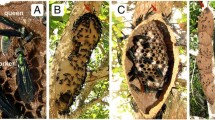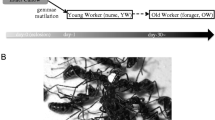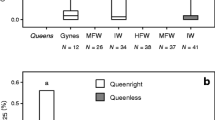Abstract
The regulation of reproduction within insect societies is a key component of the evolution of eusociality. Differential patterns of hormone levels often underlie the reproductive division of labor observed among colony members, and further task partitioning among workers is also often correlated with differences in juvenile hormone (JH) and ecdysteroid content. We measured JH and ecdysteroid content of workers and queens of the ant Harpegnathos saltator. In this species, new colonies are founded by a single queen, but after she dies workers compete in an elaborate dominance tournament to decide a new group of reproductives termed “gamergates.” Our comparisons revealed that queens, gamergates, and inside workers (non-reproductive) did not differ in levels of JH or ecdysteroids. However, increased JH and decreased ecdysteroid content was observed in outside workers exhibiting foraging behavior. Application of a JH analog to virgin queens of H. saltator, although effective at inducing dealation, failed to promote egg production. Together, these results support the hypothesis that JH has lost its reproductive function in H. saltator to regulate foraging among the worker caste.




Similar content being viewed by others
References
Adkins-Regan E (2005) Hormones and animal social behavior. Princeton University Press, Princeton
Amdam GV, Norberg K, Fondrk MK, Page RE (2004) Reproductive ground plan may mediate colony-level selection effects on individual foraging behavior in honey bees. Proc Nat Acad Sci USA 101:11350–11355
Amdam GV, Page RE, Fondrk MK, Brent CS (2010) Hormone response to bidirectional selection on social behavior. Evol Dev 12:428–436
Barker JF (1978) Neuroendocrine regulation of oocyte maturation in imported fire ant Solenopsis invicta. Gen Comp Endocrinol 35:234–237
Bergot B, Ratcliff M, Schooley D (1981) Method for quantitative determination of the four known juvenile hormones in insect tissue using gas chromatography—mass spectroscopy. J Chromatogr A 204:231–244
Bloch G, Borst D, Huang Z, Robinson G, Cnaani J, Hefetz A (2000) Juvenile hormone titers, juvenile hormone biosynthesis, ovarian development and social environment in Bombus terrestris. J Insect Physiol 46:47–57
Brent CS, Vargo EL (2003) Changes in juvenile hormone biosynthetic rate and whole body content in maturing virgin queens of Solenopsis invicta. J Insect Physiol 49:967–974
Brent C, Peeters C, Dietmann V, Crewe R, Vargo E (2006) Hormonal correlates of reproductive status in the queenless ponerine ant, Streblognathus peetersi. J Comp Physiol A 192:315–320
Burns SN, Vander Meer R, Teal PEA (2007) Juvenile hormone III concentrations in female reproductives of Solenopsis invicta Buren. J Entomol Sci 42:306–309
Cuvillier-Hot V, Gadagkar R, Peeters C, Cobb M (2002) Regulation of reproduction in a queenless ant: aggression, pheromones and reduction in conflict. Proc Roy Soc Lond B 269:1295–1300
Dolezal AG, Brent CS, Gadau J, Hölldobler B, Amdam GV (2009) Endocrine physiology of the division of labour in Pogonomyrmex californicus founding queens. Anim Behav 77:1005–1010
Dong S-Z, Ye G-Y, Guo J-Y, Hu C (2008) Role of ecdysteroid and juvenile hormone in vitellogenesis in an endoparasitic wasp, Pteromalus puparum (Hymenoptera: Pteromalidae). Gen Comp Endocr 160:102–108
Fletcher D, Ross K (1985) Regulation of reproduction in eusocial Hymenoptera. Ann Rev Entomol 30:319–343
Geva S, Hartfelder K, Bloch G (2005) Reproductive division of labor, dominance, and ecdysteroid levels in hemolymph and ovary of the bumble bee Bombus terrestris. J Insect Physiol 51:811–823
Giray T, Giovanetti M, West-Eberhard M (2005) Juvenile hormone, reproduction, and worker behavior in the neotropical social wasp Polistes canadensis. Proc Natl Acad Sci USA 102:3330
Hartfelder K (2000) Insect juvenile hormone: from “status quo” to high society. Braz J Med Biol Res 33:157–177
Heinze J, Hölldobler B, Peeters C (1994) Conflict and cooperation in ant societies. Naturwissenschaften 81:489–497
Hölldobler B, Wilson EO (1990) The ants. Harvard University Press, Cambridge
Hölldobler B, Wilson EO (2009) The superorganism: the beauty elegance and strangeness of insect societies. WW Norton & Company, New York
Jaycox ER, Skowrone W, Guynn G (1974) Behavioral changes in worker honey bees (Apis mellifera) induced by injections of a juvenile hormone mimic. Ann Entomol Soc Am 67:529–535
Klowden MJ (1997) Endocrine aspects of mosquito reproduction. Arch Insect Biochem Physiol 35:491–512
Lengyel F, Westerlund SA, Kaib M (2007) Juvenile hormone III influences task-specific cuticular hydrocarbon profile changes in the ant Myrmicaria eumenoides. J Chem Ecol 33:167–181
Liebig J, Poethke HJ (2004) Queen lifespan and colony longevity in the ant Harpegnathos saltator. Ecol Entomol 29:203–207
Liebig J, Hölldobler B, Peeters C (1998) Are ant workers capable of colony foundation? Naturwissenschaften 85:133–135
Liebig J, Peeters C, Oldham NJ, Markstadter C, Hölldobler B (2000) Are variations in cuticular hydrocarbons of queens and workers a reliable signal of fertility in the ant Harpegnathos saltator? Proc Natl Acad Sci USA 97:4124–4131
Nijhout HF (1994) Insect hormones. Princeton University Press, Princeton
Oster GF, Wilson EO (1978) Caste and ecology in the social insects. Princeton University Press, Princeton
Peeters C, Crewe R (1984) Insemination controls the reproductive division of labour in a ponerine ant. Naturwissenschaften 71:50–51
Peeters C, Liebig J, Hölldobler B (2000) Sexual reproduction by both queens and workers in the ponerine ant Harpegnathos saltator. Insect Soc 47:325–332
Raikhel AS, Brown M, Belles X (2005) Hormonal control of reproductive processes. In: Gilbert L, Gill S, Iatrou K (eds) Comprehensive molecular insect science, vol 3, Elsevier Press, Amsterdam pp 433–491
Robinson GE (1987) Regulation of honey bee age polyethism by juvenile hormone. Behav Ecol Sociobiol 20:329–338
Robinson GE, Vargo EL (1997) Juvenile hormone in adult eusocial Hymenoptera: gonadotropin and behavioral pacemaker. Arch Insect Biochem Physiol 35:559–583
Robinson GE, Strambi C, Strambi A, Feldlaufer MF (1991) Comparison of juvenile hormone and ecdysteroid haemolymph titres in adult worker and queen honey bees (Apis mellifera). J Insect Physiol 37:929–935
Robinson GE, Strambi C, Strambi A, Huang ZY (1992) Reproduction in worker honey bees is associated with low juvenile hormone titers and rates of biosynthesis. Gen Comp Endocrinol 87:471–480
Röseler P (1991) Reproductive competition during colony establishment. In: Ross KG, Matthews RW (eds) The social biology of wasps. Cornell University Press, Ithaca, pp 309–335
Röseler P, Röseler I, Strambi A, Augier R (1984) Influence of insect hormones on the establishment of dominance hierarchies among foundresses of the paper wasp, Polistes gallicus. Behav Ecol Sociobiol 15:133–142
Sasaki K, Nagao T (2001) Distribution and levels of dopamine and its metabolites in brains of reproductive workers in honeybees. J Insect Physiol 47:1205–1216
Sasaki K, Yamasaki K, Nagao T (2007) Neuro-endocrine correlates of ovarian development and egg-laying behaviors in the primitively eusocial wasp (Polistes chinensis). J Insect Physiol 53:940–949
Sasaki K, Yamasaki K, Tsuchida K, Nagao T (2009) Gonadotropic effects of dopamine in isolated workers of the primitively eusocial wasp, Polistes chinensis. Naturwissenschaften 96:625–629
Shu S, Ihl Park Y, Ramaswamy S, Srinivasan A (1997) Hemolymph juvenile hormone titers in pupal and adult stages of southwestern corn borer [Diatraea grandiosella (Pyralidae)] and relationship with egg development. J Insect Physiol 43:719–726
Sommer K, Hölldobler B, Rembold H (1993) Behavioral and physiological aspects of reproductive control in a Diacamma species from Malaysia (Formicidae, Ponerinae). Ethology 94:162–170
Sullivan JP, Jassim O, Fahrbach SE, Robinson GE (2000) Juvenile hormone paces behavioral development in the adult worker honey bee. Hormon Behav 37:1–14
Tanaka S (1986) De-alation, flight muscle histolysis, and oocyte development in the striped ground cricket, Allonemobius fasciatus. Physiol Entomol 11:453–458
Tibbetts EA, Huang ZY (2010) The challenge hypothesis in an insect: juvenile hormone increases during reproductive conflict following queen loss in Polistes wasps. Am Nat 176:123–130
Tibbetts EA, Izzo AS (2009) Endocrine mediated phenotypic plasticity: condition-dependent effects of juvenile hormone on dominance and fertility of wasp queens. Hormon Behav 56:527–531
Tschinkel WR (1988) Colony growth and the ontogeny of worker polymorphism in the fire ant, Solenopsis invicta. Behav Ecol Sociobiol 22:103–115
Vargo E, Laurel M (1994) Studies on the mode of action of a queen primer pheromone of the fire ant Solenopsis invicta. J Insect Physiol 40:601–610
Warren J, Gilbert L (1986) Ecdysone metabolism and distribution during the pupal-adult development of Manduca sexta. Insect Biochem 16:65–82
Warren J, Smith W, Gilbert L (1984) Simplification of the ecdysteroid radioimmunoassay by the use of protein A from Staphylococcus aureus. Experientia 40:393–394
West-Eberhard MJ (1978) Polygyny and the evolution of social behavior in wasps. J Kansas Entomol Soc 51:832–856
West-Eberhard MJ (1996) Wasp societies as microcosms for the study of development and evolution. In: Turillazzi S, West-Eberhard MJ (eds) Natural history and evolution of paper wasps. Oxford University Press, New York, pp 290–317
Wilson EO (1971) The insect societies. Belknap Press of Harvard University Press, Cambridge
Acknowledgments
We thank Adam Dolezal, Charity Bashore, and Dan Langhorst for help with sample processing, and Kevin Haight, Adrian Smith, and Dani Moore for comments and advice. Mention of trade names or commercial products in this article is solely for the purpose of providing specific information and does not imply recommendation or endorsement by the US Department of Agriculture.
Author information
Authors and Affiliations
Corresponding author
Rights and permissions
About this article
Cite this article
Penick, C.A., Liebig, J. & Brent, C.S. Reproduction, dominance, and caste: endocrine profiles of queens and workers of the ant Harpegnathos saltator . J Comp Physiol A 197, 1063–1071 (2011). https://doi.org/10.1007/s00359-011-0667-0
Received:
Revised:
Accepted:
Published:
Issue Date:
DOI: https://doi.org/10.1007/s00359-011-0667-0




